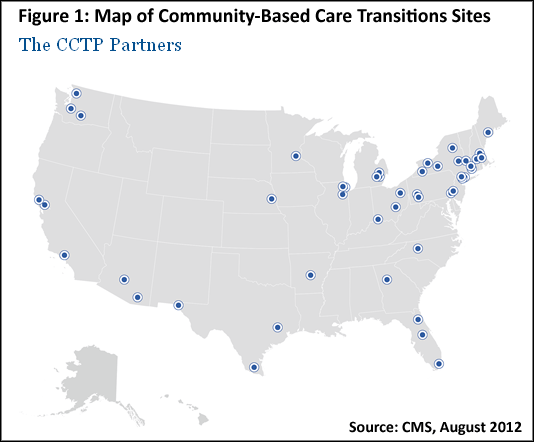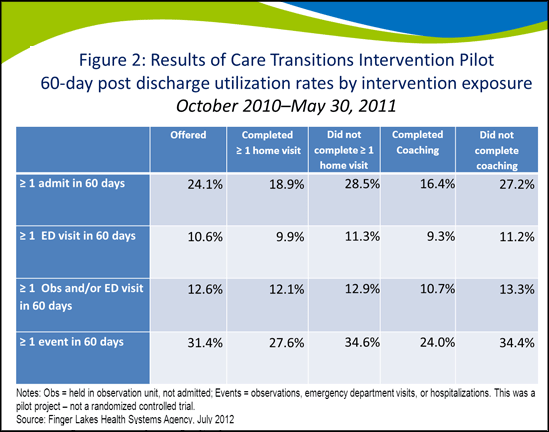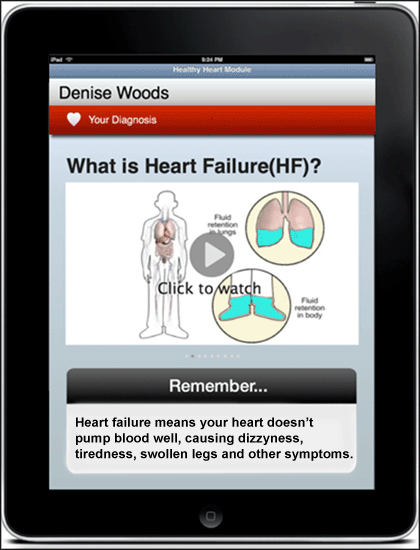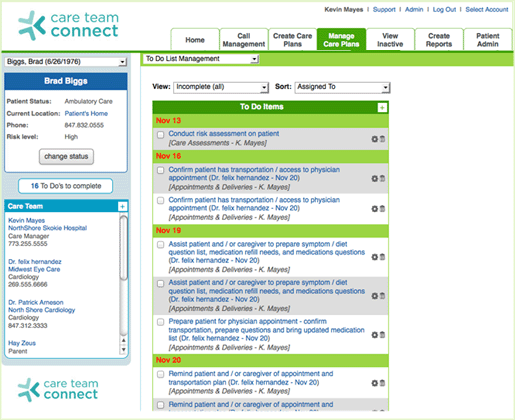Summary: In 2011, the Centers for Medicare and Medicaid launched a program to improve the care of beneficiaries who are moving from the hospital to their homes. The program, part of the Affordable Care Act, puts community-based organizations in charge of identifying these patients' needs and coordinating care to address them.
By Martha Hostetter and Sarah Klein
Many efforts to reduce preventable hospital readmissions have focused hospitals' attention on providing better care, improving discharge planning, and increasing patient education. But some of the factors that contribute to readmissions are beyond the reach of traditional improvement approaches. What happens, for instance, if a heart failure patient is discharged with no scale and no way to shop for and prepare healthful meals? What happens to continuity of care when an elder's caregiver gets sick?
The Community-Based Care Transitions Program seeks to address such breakdowns in care by encouraging partnerships between community-based organizations that provide elder services—such as Area Agencies on Aging and Aging and Disability Resource Centers—and hospitals, nursing homes, rehab facilities, and other post–acute care providers. Created through the Affordable Care Act, the $500 million program is part of the Partnership for Patients initiative, which, by 2013, aims to reduce hospital-acquired conditions among Medicare beneficiaries by 40 percent and hospital readmissions among this group by 20 percent. In addition to improving hospital discharge and care planning, it aims to support patients in achieving their own goals for health and independent living.
If successful, the program may yield significant savings for the federal government. The Medicare Payment Advisory Committee estimates that Medicare pays $15 billion each year to cover the costs of readmissions, of which $12 billion is for cases considered to be preventable. This approach reflects a departure from past, when Medicare avoided paying for care transition services out of a concern that multiple providers would bill them for providing services for the same patients, leading to duplications in service and increased costs. The Community-Based Care Transitions program avoids this by creating a single billing code. The lead community agency can bill Medicare only once for a particular beneficiary within a 180-day period.
Thus far, 47 coalitions from across the country have won competitive contracts from the Centers for Medicare and Medicaid Services (CMS) to provide care transitions services to an estimated 185,000 Medicare beneficiaries across 21 states (Figure 1).1
As part of the application process, participants perform root cause analyses to identify factors leading to readmissions in their communities, such as inadequate care coordination, poor medication management, social or environmental risks, and cultural and language barriers. They then propose a plan to work together to help beneficiaries recover from whatever brought them to the hospital and manage their conditions to avoid future complications. Applicants also must outline a budget encompassing the costs of care transitions services provided to enrolled beneficiaries in the 180 days after their hospital discharge.

Many of the groups are using an improvement model developed by Eric Coleman, M.D., M.P.H., professor of medicine and head of the University of Colorado School of Medicine's Division of Health Care Policy and Research, that seeks to engage patients at critical transition points (see Q&A).2Coleman's Care Transitions Intervention (CTI) relies on specially trained coaches, who typically have backgrounds in nursing or social work, to educate patients about medication management and the use of personal health records, along with other efforts to facilitate care continuity and communication with their providers. The coaches, who visit patients in the hospital and make home visits and phone calls for 28 days after discharge, also provide guidance that helps patients recognize symptoms indicating their condition is worsening.
Other groups are relying on a model developed by Mary Naylor, Ph.D., R.N., a professor of gerontology and director of the New Courtland Center for Transitions and Health at the University of Pennsylvania's School of Nursing. Naylor's approach, known as the Transitional Care Model, uses advanced practice nurses to oversee patients' care transitions. The nurses create customized care plans for patients while they are hospitalized and then make regular home visits for an average of two months after discharge. Both Coleman and Naylor's care transition models seek to develop patients' ability to manage their own conditions, and some Community-Based Care Transitions programs are combining aspects of both approaches.
Early Adopters
Below are profiles of five different groups that have already received funding under the Community-Based Care Transitions Program.
Elder Services of Merrimack Valley
Elder Services of Merrimack Valley, Inc., which serves elders in northern Massachusetts and southern New Hampshire, was one of the first community-based organizations to win a contract from CMS, in November 2011.3The funding has enabled it to place a staff member in local hospitals, says Rosanne DiStefano, M.U.A., the organization's executive director. "We never knew previously when someone was discharged," she says. "Now we have a lead coach from our agency in each of the five hospitals, working side by side with discharge planners. That's huge—it means we can begin the process [of providing services] much sooner."
Medicare beneficiaries enrolled in the program will be visited by a transitions coach a few days after discharge to assess their need for various support services. These might include an immediate at-home visit, interpretation services by a bilingual coach, mental health assessments, nutritional coaching, or assistance in purchasing necessities such as groceries or medical supplies. Medicare makes an all-inclusive payment for each beneficiary, with the rate calculated based on the combination of services provided. (Neither CMS nor the awardees have disclosed the payment amounts made under the program.)
Lifespan
Lifespan, an Area Agency on Aging providing services to residents in the Greater Rochester region of western New York, is partnering with four hospitals, two home health agencies, and the Finger Lakes Health Systems Agency, an independent organization working to improve health care in the region. Operating in a region known for collaboration, the Finger Lakes Health Systems Agency led a 2010–11 pilot of the Care Transitions Intervention among privately insured patients in four area hospitals. Rates of hospitalizations and emergency department visits were notably lower among those who completed the coaching, compared with those who did not (Figure 2).

Based on this experience, the partners designed a two-pronged intervention to expand the work to Medicare beneficiaries under the Community-Based Care Transitions program. It involves the use of coaching as well as enhanced interventions in the hospital. For the latter, pharmacists help obtain an accurate medication history at admission, take part in daily "huddles" to discuss the status of enrolled patients, and review all medications prior to discharge. Hospitals have developed their own interventions as well: one is using a facilitator to promote effective communication between discharge planners and transition coaches, while another contracted with a call center to facilitate calls between hospitalists and patients' primary care physicians and/or nursing home medical directors.
"The advantage of working with Lifespan is that they have over 30 services, like Meals on Wheels and financial planning, that they provide to elders," says Melissa Wendland, associate director for planning and research at Finger Lakes Health Systems Agency. "This is going to make the program more fine-tuned, so coaches can help people access the resources they need to fulfill their goals."
To help coaches develop their skills, the agency convened a learning collaborative that brings them together to talk about their successes and challenges. Topics discussed are suggested by coaches, and have included sessions on how to work with patients who have a history of substance abuse and how to become a trusted member of hospital team. Participants learn from their peers by shadowing each other and offering feedback.
"A big issue is to stick to coaching and not take over—coaches have a huge desire to fix the problem," says Howard Beckman, M.D., clinical professor of medicine and family medicine at the University of Rochester School of Medicine and Dentistry and chief medical officer of Focused Medical Analytics. "We need to remind everyone what coaching is designed to be: what will patients be able to do for themselves after 30 days [when the coaching ends]?" says Beckman, who acts as a facilitator for the Lifespan collaboration.
Marin County Division of Aging and Adult Services
Marin County, Calif., has been engaged in improving care transitions since 2001, using grant money allocated by the county's board of supervisors. That program, Project Independence, relies on public health nurses who work closely with a pool of volunteers and nursing and pharmacy students to educate frail, elderly patients about their conditions and address impediments to adhering to a plan of care, such as a lack of transportation to physicians' offices or the supermarket. "It's people helping people fill in those gaps," said Rita Widergren, B.S.N., the supervising public health nurse for Project Independence. Between 2007 and 2010, only 4 percent of patients in the program were readmitted to the hospital within 30 days of discharge.
When the county joined Medicare's initiative in March of this year, it formed a second organization, Advanced Care Transitions, which places nurses in local hospitals to identify Medicare patients in need of services, regardless of their diagnoses. The patients will be followed for eight weeks, and services provided will vary depending on patients' level of engagement and health literacy: some will receive the services of a health coach, while others will get support from a health coach and a team of volunteers and nursing and pharmacy students.
Pierce County Area Agency on Aging
In Pierce County, Wash., the Area Agency on Aging has teamed up with two health systems comprising six hospitals and several primary care clinics, as well as the local school of nursing, to identify and assist patients at risk for readmissions. Staff from the agency and health systems meet weekly to discuss the needs of patients who have been referred to the program by the hospitals. Patients with lower risk scores may receive one or more follow-up calls, while patients with more serious conditions receive home visits as well. Nursing students follow patients with congestive heart failure.
Council on Aging of Southwestern Ohio
The Council on Aging of Southwestern Ohio is partnering with five local hospitals and the local mental health board to target beneficiaries in need of transition services. Like other groups, the Ohio collaboration is using health information technology to help them improve care transitions (see below). A Cincinnati-based health information exchange, HealthBridge, is providing software that sends Council on Aging an electronic alert when a patient receiving community-based services, such as home care or Meals on Wheels, visits the emergency department or is admitted to the hospital. These alerts may then lead to the initiation of the Care Transition Intervention for those who need it.
The Greater Cincinnati Health Council is serving as a neutral convener of physician practices and hospitals, says Ken Wilson, M.G.S., the Council on Aging's director of program operations. "They host meetings across the partners involved in the program to look at what's working and what's not," he says. "They provide a safe place to talk about how to improve."
Challenges Ahead
CMS will be monitoring the effects of the program by having participants track service use among enrolled beneficiaries, including 30-day readmission rates, 90- and 180-day readmission rates, mortality rates, use of observation services, and emergency department visits. Participants also must monitor changes over time in beneficiaries' scores on the Patient Activation Measure, which gauges their knowledge, skills, and confidence in managing their health and care.
Overall, CMS hopes to save money from the program by helping communities develop local strategies to improve care transitions and avoid unnecessary hospitalizations. A study of Coleman's model found patients who received his intervention had lower rehospitalization rates compared with control subjects at 30 days (8.3 percent vs. 11.9 percent) and 90 days (16.7 percent vs. 22.5 percent). The mean hospital costs were lower for intervention patients ($2,058) than for controls ($2,546) at 180 days. A study examining the use of Naylor's model among beneficiaries enrolled in Aetna's Medicare Advantage plan found it led to improvements in health status and quality-of-life measures. The group that received the intervention had 25 percent fewer rehospitalizations and 28 percent lower number of total hospital days after three months. The intervention also was associated with a cumulative per member savings of $2,170 at one year.5
"The costs of providing high-touch care in the community setting are always dwarfed by the cost of a hospitalization," says Amy Boutwell, M.D., M.P.P., founder of Collaborative Healthcare Strategies, who advised several communities during the application process. "CMS never specified the magnitude of the savings they expect, however my analysis is that programs can do much better than budget neutral, and should be in the net 25 to 40 percent savings range." Boutwell points out that CMS funding cannot be used for infrastructure investments, such as a common information and tracking system platform across organizations and settings, and is concerned this policy may limit participants' ability to deliver coordinated services and measure the results of their work.
Another limitation of the program is that it targets only those whose conditions have already worsened to the point where they become hospitalized, notes Ellen T. Kurtzman, M.P.H., R.N., assistant research professor at George Washington University's School of Nursing and one of the authors of a recent study, suggesting policies to improve the program. "Many frail older adults who would benefit from these kinds of transitional care services—such as nursing home residents who are moving back to their homes, those who move to a different level of care within a continuing care retirement community, or patients who are being discharged to their homes from psychiatric or rehab hospitals—are not eligible for the program. Further, Kurtzman says, policies promoting better primary care, individualized care planning, patient education and medication support, and better communication among providers could ameliorate older adults' risk for hospitalization in the first place.
Because they don't receive funding, hospitals have no direct financial incentive to join the program. But with more than 2,000 hospitals set to be penalized by CMS for high readmission rates—and a growing movement to reward coordinated, accountable care—nearly all hospitals are looking for ways to reduce readmissions.6
Thus far, some 200 hospitals are participating in the program, including many that are competitors. This level of collaboration is a "game-changer," notes Boutwell. "Even where well-established readmissions work exists, the cross-setting—and especially cross-hospital—collaboration is new, feels risky, and exists usually because of the vision of a champion or small group of champions."
New Technology Supports Smooth Care TransitionsIn the Community-Based Care Transitions Program, community-based agencies provide coaching and education to patients as they make the transition from hospital to home. Complementing this "high-touch" approach are a number of technology solutions developed by firms such as North Carolina–based Axial Exchange, Illinois-based Care Team Connect, and California–based Engineered Care that educate patients, track their progress after discharge, and identify gaps in care. Source: Axial Exchange Source: Care Team Connect; example record based on fictional patient. |
Notes
2 Dr. Coleman is a member of Quality Matters' editorial advisory board.
3 Before partnering for this program, Elder Services of Merrimack Valley and five area hospitals had already been working together in the Commonwealth Fund–supported STate Action to Avoid Rehospitalization (STAAR) initiative.
4 E. A. Coleman, C. Parry, S. Chalmers et al., "The Care Transitions Intervention: Results of a Randomized Controlled Trial," Archives of Internal Medicine, Sept. 2006 166(17):1822–28.
5 M. D. Naylor, K. H. Bowles, K. M. McCauley et al., "High Value Transitional Care: Translation of Research into Practice," Journal of Evaluation in Clinical Practice, published March 16, 2011.
6 Starting this October, hospitals deemed to have "excessive" readmission rates will be penalized by losing up to 1 percent of their basic Medicare reimbursement, with the penalty rising to 2 percent in 2013 and 3 percent the following year. A recent analysis found that this policy will affect more than 2,000 hospitals across the nation in 2012.




